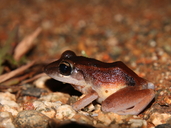|
Description
These frogs are reddish brown to tan or gray. Sometimes there are light dorsolateral stripes. There is usually an interorbital bar, a supratympanic mark and a scapular bar, all of them black in color. The concealed surfaces of thighs are red and the venter is white. A black spot on the base of thigh and in groin can be present (by subspecies). The vomerine teeth, behind the coanes, are in transverse and long series. There is no webbing between the toes and there are no digital disks. Adult size is moderate, 43 mm in females, males are smaller. Distribution and Habitat
Country distribution from AmphibiaWeb's database: Cuba
This species is endemic of Cuba, Isla de la Juventud and Archipiélago de Sabana-Camaguey. This species is found islandwide, from sea level to about 4000 feet (~1200 meters) and it occurs in woods, scrubs, coffee and other plantations and in human habitations.Life History, Abundance, Activity, and Special Behaviors
This frog is a direct developing species, ovipositing in moist soil and under rocks and fallen trunks. Clutches are composed of spherical, orange, semitransparent eggs, 3-4 mm in diameter. They are active at night, males vocalize from the ground emitting a series of bird-like twittering or clicks, similar to water dropping from a leaky faucet. Trends and Threats
Some natural areas in Eastern Cuba have been degraded and substituted by pastures inducing the extinction of this species of its original habitat. Nevertheless, it is able to survive in areas where coffee or timber plantations have substituted natural vegetation. Possible reasons for amphibian decline General habitat alteration and loss
Intensified agriculture or grazing
References
Dunn, E. R. (1925). ''Additional frogs from Cuba.'' Occasional Papers of the Boston Society of Natural History, 5, 209-215.
Fong, A. (1999). ''Changes in amphibian composition in altered habitats in eastern Cuba.'' Froglog, 36, 2.
Lynch, J. (1991). ''Three replacement names for preoccupied names in the genus Eleutherodactylus (Amphibia: Leptodactylidae).'' Copeia, 4, 1138-1139.
Novo, J., Estrada, A. R., and Moreno, L. V. (1987). ''Apuntes sobre la reproducción de Eleutherodactylus atkinsi (Anura: Leptodactylidae).'' Miscellaneous Zoology, 29, 2-3.
Ruiz, F. N. (1987). Anfibios de Cuba. Cientifíco-Técnica, La Habana.
Schwartz, A . and Henderson, R. W. (1985). A Guide to the Identification of the Amphibians and Reptiles of the West Indies Exclusive of Hispaniola. Milwaukee Public Museum, Milwaukee.
Schwartz, A. and Henderson, R. W. (1991). Amphibians and Reptiles of the West Indies: Descriptions, Distributions and Natural History. University Press of Florida, Florida.
Originally submitted by: Ansel Fong G. (first posted 2004-01-27)
Edited by: Tate Tunstall (2004-02-27)Species Account Citation: AmphibiaWeb 2004 Eleutherodactylus atkinsi: Cuban Groin-spotted Frog <https://amphibiaweb.org/species/2781> University of California, Berkeley, CA, USA. Accessed Jun 7, 2025.
Feedback or comments about this page.
Citation: AmphibiaWeb. 2025. <https://amphibiaweb.org> University of California, Berkeley, CA, USA. Accessed 7 Jun 2025.
AmphibiaWeb's policy on data use.
|
